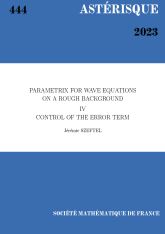- Consulter un extrait
- Année : 1998
- Tome : 251
- Format : Électronique
- Langue de l'ouvrage :
Anglais - Class. Math. : Primary 11G25; Secondary 14G25
- Pages : 1-12
- DOI : 10.24033/ast.407
Soient $V$ une surface cubique non singulière définie sur $\mathbb Q$ et $U$ le complémentaire des $27$ droites de $V$. On note $N(U,H)$ le nombre de points rationnels de $U$ de hauteur plus petite que $H$. Manin a conjecturé que, si $V(\mathbb Q)$ n'est pas vide, alors $ N(U,H)=C_1H(\log H)^{r-1}(1+o(1))$ où $C_1$ est une constante strictement positive et $r$ le rang du groupe de Néron-Severi $NS(V/{\mathbb Q})$ de $V$ sur $\mathbb Q$. Dans cet article nous considérons le cas particulier où $V$ contient deux droites rationnelles disjointes ; et nous prouvons qu'il existe une constante $C_2>0$ telle que pour tout réel $H$ assez grand on ait $N(U,H)>C_2H(\log H)^{r-1}.$ Ceci donne la minoration dans l'estimation asymptotique (1). Il est probable que les arguments de ce texte puissent être modifiés pour montrer le résultat correspondant quand $V$ contient deux droites disjointes conjuguées sur $\mathbb Q$ de sorte que chacune soit définie sur une extension quadratique de $\mathbb Q$. Mais nous n'avons pas entrepris de rédiger les détails.


